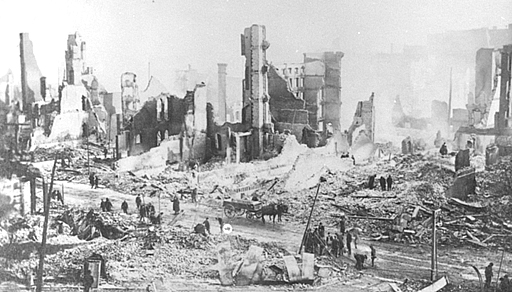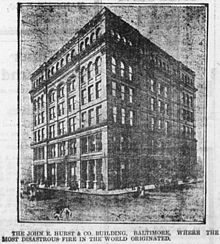Welcome to DU!
The truly grassroots left-of-center political community where regular people, not algorithms, drive the discussions and set the standards.
Join the community:
Create a free account
Support DU (and get rid of ads!):
Become a Star Member
Latest Breaking News
General Discussion
The DU Lounge
All Forums
Issue Forums
Culture Forums
Alliance Forums
Region Forums
Support Forums
Help & Search
General Discussion
Related: Editorials & Other Articles, Issue Forums, Alliance Forums, Region ForumsOn this day, Sunday, February 7, 1904, fire was reported in the John E. Hurst Building in Baltimore.
I worked with a guy whose grandfather had a farm well north of Baltimore. He said that you could see the glow in the sky from the Mason-Dixon Line.
The anniversary usually coincides with the opening of the college lacrosse season. There's no reason; it's just one of those things.
Great Baltimore Fire

The aftermath of the fire
The Great Baltimore Fire raged in Baltimore, Maryland, United States on Sunday, February 7 and Monday, February 8, 1904. More than 1,500 buildings were completely leveled, and some 1,000 severely damaged, bringing property loss from the disaster to an estimated $100 million. 1,231 firefighters helped bring the blaze under control, both professional paid Truck and Engine companies from the Baltimore City Fire Department (B.C.F.D.) and volunteers from the surrounding counties and outlying towns of Maryland, as well as out-of-state units that arrived on the major railroads. It destroyed much of central Baltimore, including over 1,500 buildings covering an area of some 140 acres (57 ha). From North Howard Street in the west and southwest, the flames spread north through the retail shopping area as far as Fayette Street and began moving eastward, pushed along by the prevailing winds. Narrowly missing the new 1900 Circuit Courthouse (now Clarence M. Mitchell, Jr. Courthouse), fire passed the historic Battle Monument Square from 1815 to 1827 at North Calvert Street, and the quarter-century-old Baltimore City Hall (of 1875) on Holliday Street; and finally spread further east to the Jones Falls stream which divided the downtown business district from the old East Baltimore tightly-packed residential neighborhoods of Jonestown (also known as Old Town) and newly named "Little Italy". The fire's wide swath burned as far south as the wharves and piers lining the north side of the old "Basin" ( today's "Inner Harbor" ) of the Northwest Branch of the Baltimore Harbor and Patapsco River facing along Pratt Street. It is considered historically the third worst conflagration in an American city, surpassed only by the Great Chicago Fire of 1871, and the San Francisco Earthquake and Fire of 1906. Other major urban disasters that were comparable (but not fires) were the Galveston Hurricane of 1900 and most recently, Hurricane Katrina that hit New Orleans and the Gulf of Mexico coast in August 2005.
One reason for the fire's long duration involved the lack of national standards in firefighting equipment. Despite fire engines from nearby cities (such as Philadelphia and Washington, D.C. as well as units from New York City, Virginia, Wilmington, and Atlantic City) responding with horse-drawn pumpers, wagons and other related equipment (primitive by modern-day standards, but only steam engines were motorized in that era) carried by the railroads on flat cars and box cars, many were unable to help since their hose couplings could not fit Baltimore's fire hydrants.
Much of the destroyed area was rebuilt in relatively short order, and the city adopted a building code, stressing fireproof materials. Perhaps the greatest legacy of the fire was the impetus it gave to efforts to standardize firefighting equipment in the United States, especially hose couplings.
....
Progression of the fire

John E. Hurst Building, site of the fire's outbreak
Fire was reported first at the John Hurst and Company building on West German Street at Hopkins Place (modern site at the southwest corner of the Baltimore Civic Center of 1962, currently the Royal Farms Arena) in the western part of downtown Baltimore at 10:48 a.m. on Sunday, February 7, and quickly spread. Soon, it became apparent that the fire was outstripping the ability of the city's firefighting resources to fight it, and calls for help were telegraphed to other cities. By 1:30 p.m., units from Washington, D.C. were arriving on the Baltimore and Ohio Railroad at Camden Street Station. To halt the fire, officials decided to use a firebreak, and dynamited buildings around the existing fire. This tactic, however, proved unsuccessful. Not until 5:00 p.m. the next day was the fire brought under control, after burning for thirty hours.

The aftermath of the fire
The Great Baltimore Fire raged in Baltimore, Maryland, United States on Sunday, February 7 and Monday, February 8, 1904. More than 1,500 buildings were completely leveled, and some 1,000 severely damaged, bringing property loss from the disaster to an estimated $100 million. 1,231 firefighters helped bring the blaze under control, both professional paid Truck and Engine companies from the Baltimore City Fire Department (B.C.F.D.) and volunteers from the surrounding counties and outlying towns of Maryland, as well as out-of-state units that arrived on the major railroads. It destroyed much of central Baltimore, including over 1,500 buildings covering an area of some 140 acres (57 ha). From North Howard Street in the west and southwest, the flames spread north through the retail shopping area as far as Fayette Street and began moving eastward, pushed along by the prevailing winds. Narrowly missing the new 1900 Circuit Courthouse (now Clarence M. Mitchell, Jr. Courthouse), fire passed the historic Battle Monument Square from 1815 to 1827 at North Calvert Street, and the quarter-century-old Baltimore City Hall (of 1875) on Holliday Street; and finally spread further east to the Jones Falls stream which divided the downtown business district from the old East Baltimore tightly-packed residential neighborhoods of Jonestown (also known as Old Town) and newly named "Little Italy". The fire's wide swath burned as far south as the wharves and piers lining the north side of the old "Basin" ( today's "Inner Harbor" ) of the Northwest Branch of the Baltimore Harbor and Patapsco River facing along Pratt Street. It is considered historically the third worst conflagration in an American city, surpassed only by the Great Chicago Fire of 1871, and the San Francisco Earthquake and Fire of 1906. Other major urban disasters that were comparable (but not fires) were the Galveston Hurricane of 1900 and most recently, Hurricane Katrina that hit New Orleans and the Gulf of Mexico coast in August 2005.
One reason for the fire's long duration involved the lack of national standards in firefighting equipment. Despite fire engines from nearby cities (such as Philadelphia and Washington, D.C. as well as units from New York City, Virginia, Wilmington, and Atlantic City) responding with horse-drawn pumpers, wagons and other related equipment (primitive by modern-day standards, but only steam engines were motorized in that era) carried by the railroads on flat cars and box cars, many were unable to help since their hose couplings could not fit Baltimore's fire hydrants.
Much of the destroyed area was rebuilt in relatively short order, and the city adopted a building code, stressing fireproof materials. Perhaps the greatest legacy of the fire was the impetus it gave to efforts to standardize firefighting equipment in the United States, especially hose couplings.
....
Progression of the fire

John E. Hurst Building, site of the fire's outbreak
Fire was reported first at the John Hurst and Company building on West German Street at Hopkins Place (modern site at the southwest corner of the Baltimore Civic Center of 1962, currently the Royal Farms Arena) in the western part of downtown Baltimore at 10:48 a.m. on Sunday, February 7, and quickly spread. Soon, it became apparent that the fire was outstripping the ability of the city's firefighting resources to fight it, and calls for help were telegraphed to other cities. By 1:30 p.m., units from Washington, D.C. were arriving on the Baltimore and Ohio Railroad at Camden Street Station. To halt the fire, officials decided to use a firebreak, and dynamited buildings around the existing fire. This tactic, however, proved unsuccessful. Not until 5:00 p.m. the next day was the fire brought under control, after burning for thirty hours.
InfoView thread info, including edit history
TrashPut this thread in your Trash Can (My DU » Trash Can)
BookmarkAdd this thread to your Bookmarks (My DU » Bookmarks)
2 replies, 360 views
ShareGet links to this post and/or share on social media
AlertAlert this post for a rule violation
PowersThere are no powers you can use on this post
EditCannot edit other people's posts
ReplyReply to this post
EditCannot edit other people's posts
Rec (2)
ReplyReply to this post
2 replies
 = new reply since forum marked as read
Highlight:
NoneDon't highlight anything
5 newestHighlight 5 most recent replies
= new reply since forum marked as read
Highlight:
NoneDon't highlight anything
5 newestHighlight 5 most recent replies
On this day, Sunday, February 7, 1904, fire was reported in the John E. Hurst Building in Baltimore. (Original Post)
mahatmakanejeeves
Feb 2020
OP
NewJeffCT
(56,828 posts)1. Thanks for that history
fascinating story - at least some good came out of that terrible event.
pansypoo53219
(20,987 posts)2. milw had a smaller fire. 3rd ward i think.